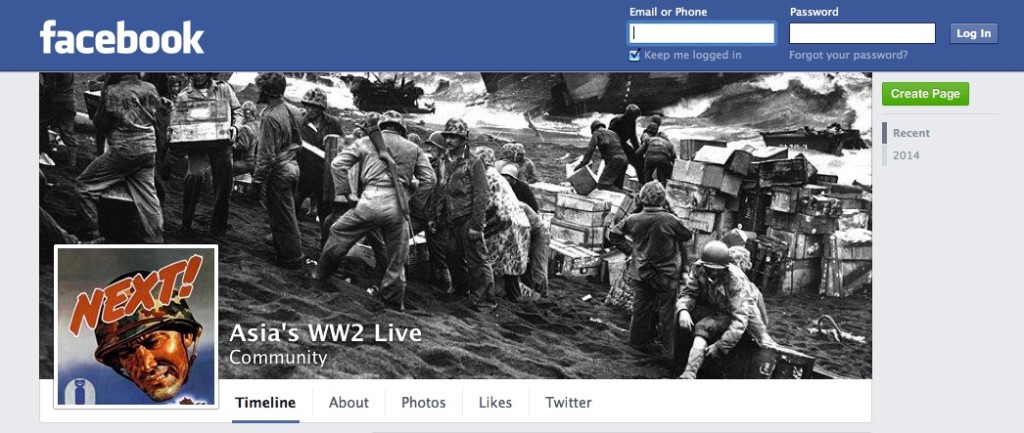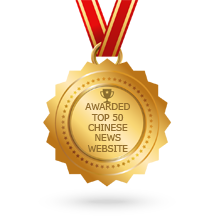Time Travel in Cyberspace
- By Guest blogger
- 11 August, 2014
- 1 Comment
 This article about a new project to chronicle World War Two in Asia in real time was first published on the website of the Danish Broadcasting Corp. It was written by long-time Asia hand Asger Rojle. See his website here.
This article about a new project to chronicle World War Two in Asia in real time was first published on the website of the Danish Broadcasting Corp. It was written by long-time Asia hand Asger Rojle. See his website here.
Every day for the next 11 years Facebook and Twitter users can follow news about World War Two in Asia as it would have appeared if the Internet had existed back then – with a time lag of exactly 80 years.
The project has been started by Peter Harmsen, a journalist with 20 years of experience covering Asia, mostly China and Taiwan.
Two-way communication
“I picked the social media because they provide more opportunities for two-way communication. It’s my objective to initiate a dialogue with others who share an interest in this period of world history,” Peter Harmsen said.
“You don’t have to be a registered user of Facebook or Twitter to follow the project. Anyone with access to the Internet can visit Facebook and Twitter and see what I’m doing.” (For the Facebook page, click here. For Twitter, here.)
“I’d like to see a debate on questions such as ‘would it have had any significant impact on the war in the Pacific if the Chinese leader Chiang Kai-shek had thrown in the towel in the early 1940s and liberated Japan from the burden of maintaining huge garrisons in China?”
If the project leads to this kind of dialogue and debate, it will have been worthwhile, according to Harmsen.
Peter Harmsen himself is motivated by a “an all-consuming interest in Chinese and Asian history, especially in the 193os and 1940s.”
“In addition, the degree to which China’s role in World War Two has been neglected by the public and the historians is a bit of a puzzle for me. You can speculate what the reasons might be, but I think the language barrier is the most important one.”
One can only guess what world history would have looked like if China had not sucked so many resources out of the Japanese war machine. How strong resistance would Japan have been able to offer the United States? And how many resources would the US have been able to devote to the war against Nazi Germany in Europe?
Last year Peter Harmsen published a book about the Sino-Japanese battle for Shanghai in 1937. It was extremely bloody, even by the standards of the subsequent battle on the Eastern Front, but even so it has never been the subject of a monograph in any western language.
“So I decided to write the book I myself would have liked to read about the subject,” Peter Harmsen said.
Day by day
Work on the book convinced Peter Harmen that it would be useful to communicate directly with the readers, which motivated him to set up a Facebook page and a Twitter account with a focus on the war in China. In turn, this led to the idea of a parallel project with a more chronological, day-by-day approach to the subject.

Nationalist Chinese troops fighting communist guerrillas in the 1930s
“I thought it made sense to start off exactly 80 years ago, in 1934, as it would allow me to include most of the pre-war history. We often look at the Pacific War as a fairly brief affair, beginning with Japan’s attack on the US and other western powers in December 1941 and ending with Hiroshima and Nagasaki in the summer of 1945. But before this cataclysm we had a long, extremely complicated by also extremely interesting prelude which involved not just Japan and the United States, but a series of other actors right down to the level of autonomous warlords in remote Chinese provinces,” Peter Harmsen said.
Reading this history in the form of daily news makes it possible “to experience history the way the contemporaries experienced it, one day at a time without knowing how it would all end,” he said.
Divergent trends
At the same time, the daily news format allows him to tell small stories which illustrate more fundamental trends or challenge conventional wisdom about history.
“Take for example the entry on Facebook and Twitter for July 18, 1934. It’s about the Harvard baseball team departing for a tour of Japan. It’s a reminder that Japan wasn’t a monolithic militant society, and that there was a fascination with western culture in the Japanese public. There were lots of divergent trends, pulling in different directions.”
Keeping up with technology
“I have been interested in the Pacific War since I went to high school in the 1980s. But if I contribute to a better understanding of the history that makes the current diplomatic issues in East Asia so intractable, I would of course consider that a plus.”
Even though he has set himself a task that will keep him busy for the next 11 years, Peter Harmsen doesn’t feel overwhelmed.
“As long as it remains as interesting as it is now, it’s not overwhelming at all. But the 11-year time frame means you have to think ahead. Will Facebook and Twitter still be around in the same form in 2025? They will probably have developed significantly by then. So it’s important to keep up with technology and adjust the project so it still has wide appeal without abandoning the central point, which is to chronicle history in real time, 80 years after the fact,” he said.



 Copyright © 2024
Copyright © 2024
Hey Peter
This is such a fantastic idea and quite a commitment as well! I appreciate the chance to learn more about Asia during World War Two. I know a lot of my buddies want the same.
Good luck & thanks!
Warm regards,
Jack